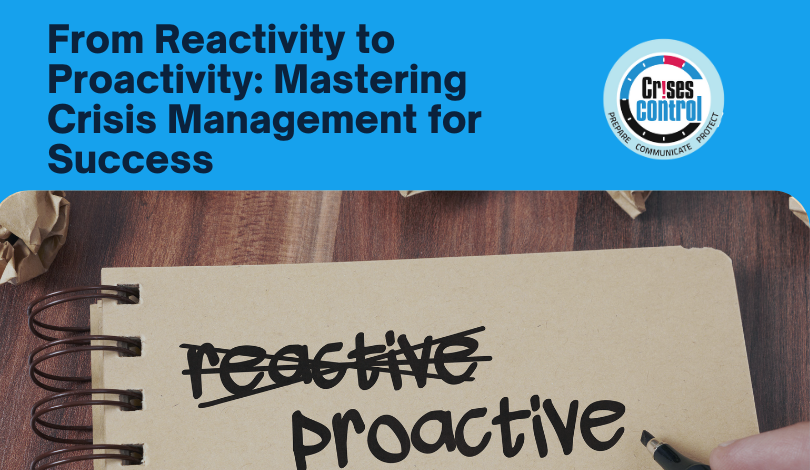Have you ever wondered why some companies effortlessly navigate through storms of crisis, emerging even stronger, while others struggle and falter in the face of adversity? The secret lies in their ability to distinguish between reactivity and proactivity in crisis management. In an ideal scenario, every organisation aspires to be proactive during a crisis, but without proper plans and measures in place, they often find themselves forced into reactive mode, falling short of their goals.
Imagine a scenario: Two companies, both hit by a sudden market disruption. Company A, reactive and unprepared, scrambles to address the crisis, making hasty decisions and struggling to regain control. On the other hand, Company B, proactive and well-prepared, anticipates the potential challenges, executes a carefully crafted plan, and not only mitigates the crisis but also seizes the opportunity to outperform its competitors. What sets Company B apart? How can you ensure your organisation follows a similar trajectory?
In this blog, we explore the critical distinction between reactivity and proactivity in crisis management and delve into the strategies and principles that separate successful companies from their struggling counterparts.
The Power of Preparation: Building a Strong Foundation
Preparation forms the bedrock of effective crisis management. Organisations must invest time and resources in building a strong foundation that enables them to navigate crises successfully. This involves developing robust crisis response strategies, protocols, and structures that can be activated at a moment’s notice. By proactively identifying potential risks and vulnerabilities, organisations can develop tailored solutions and contingency plans that address specific challenges they may face. By leveraging tools such as Crises Control’s task manager and incident plan builder features, organisations can streamline their crisis response efforts, assign responsibilities, and ensure a coordinated and efficient response.
Anticipating and Identifying Risks: The Role of Risk Assessment
A critical component of proactive crisis management is the systematic assessment and identification of risks. By conducting thorough risk assessments, organisations can gain insights into potential threats and vulnerabilities. This allows them to take preemptive measures to mitigate risks before they escalate into crises. Proactive risk assessment involves analysing various factors such as market trends, emerging technologies, regulatory changes, and external influences. By staying ahead of the curve, organisations can identify early warning signs and take proactive steps to minimise potential damage.
Effective Communication: The Key to Proactive Crisis Response
Effective communication lies at the heart of proactive crisis management. In times of crisis, clear and timely communication is essential to minimise confusion, provide accurate information, and maintain stakeholder trust. Organisations should establish robust communication channels and protocols that enable rapid dissemination of information to all relevant parties. Proactive crisis communication involves proactive outreach, regular updates, and transparency to keep stakeholders informed and engaged. By maintaining open lines of communication, organisations can respond proactively and effectively to crises, mitigating their impact.
Training and Drills: Practice Makes Proactive
Practice and preparedness are vital components of proactive crisis management. Organisations should invest in regular training and drills to enhance crisis response readiness. Simulated exercises can help teams identify gaps in their response capabilities, test the effectiveness of their plans, and improve coordination among stakeholders. By creating a culture of preparedness, organisations can ensure that their crisis management teams are well-equipped to handle crises confidently and efficiently. With Crises Control’s training and drill features, organisations can effectively simulate crises and evaluate their readiness, further enhancing their proactive crisis management approach.
Continuous Improvement: Learning from Past Crises
Proactive crisis management is an ongoing process that involves continuous improvement and learning from past experiences. After a crisis has been resolved, organisations should conduct post-crisis analysis and lessons learned exercises. By critically evaluating their response strategies, identifying areas for improvement, and implementing corrective actions, organisations can refine their crisis management approaches. This iterative process allows businesses to adapt and evolve, ensuring they are better prepared for future crises.
Conclusion
Mastering crisis management requires a proactive mindset and a comprehensive approach. By shifting from reactive to proactive strategies, organisations can anticipate, prepare for, and effectively respond to crises. Building a strong foundation, conducting risk assessments, establishing effective communication channels, investing in training, and fostering a culture of continuous improvement are all key steps in the journey towards proactive crisis management. By embracing these principles and practices, businesses can navigate challenges, protect their stakeholders, and position themselves for success in an ever-changing world.
Ready to transform your organisation’s crisis management approach from reactive to proactive? Contact us today to discover how our expertise and solutions can help you thrive in the face of adversity. Request a live demo of our comprehensive crisis management tools and let us guide you towards a future of success. Don’t let crises define your organisation – take charge and be proactive. Reach out now and unlock the power of effective crisis management.







